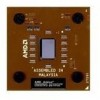AMD AXDA3200DKV4E Data Sheet - Page 52
AMD Athlon™ Processor-Based Motherboard Design Guide, AMD Thermal, Mechanical
 |
View all AMD AXDA3200DKV4E manuals
Add to My Manuals
Save this manual to your list of manuals |
Page 52 highlights
Preliminary Information AMD Athlon™ XP Processor Model 10 Data Sheet 26237C-May 2003 Thermal limits in motherboard design are necessary to protect the processor from thermal damage. TSHUTDOWN is the temperature for thermal protection circuitry to initiate shutdown of the processor. TSD_DELAY is the maximum time allowed from the detection of the over-temperature condition to processor shutdown to prevent thermal damage to the processor. Systems that do not implement thermal protection circuitry or that do not react within the time specified by TSD_DELAY can cause thermal damage to the processor during the unlikely events of fan failure or powering up the processor without a heat-sink. The processor relies on thermal circuitry on the motherboard to turn off the regulated core voltage to the processor in response to a thermal shutdown event. Thermal protection circuitry reference designs and thermal solution guidelines are found in the following documents: ■ AMD Athlon™ Processor-Based Motherboard Design Guide, order# 24363 ■ AMD Thermal, Mechanical, and Chassis Cooling Design Guide, order# 23794 See http://www.amd.com for more information about thermal solutions. Table 18 shows the TSHUTDOWN and TSD_DELAY specifications for circuitry in motherboard design necessary for thermal protection of the processor. Table 18. Guidelines for Platform Thermal Protection of the Processor Symbol Parameter Description Max Units Notes TSHUTDOWN Thermal diode shutdown temperature for processor protection 125 °C 1, 2, 3 TSD_DELAY Maximum allowed time from TSHUTDOWN detection to processor shutdown 500 ms 1, 3 Notes: 1. The thermal diode is not 100% tested, it is specified by design and limited characterization. 2. The thermal diode is capable of responding to thermal events of 40°C/s or faster. 3. The AMD Athlon™ XP processor model 10 provides a thermal diode for measuring die temperature of the processor. The processor relies on thermal circuitry on the motherboard to turn off the regulated core voltage to the processor in response to a thermal shutdown event. Refer to AMD Athlon™ Processor-Based Motherboard Design Guide, order# 24363, for thermal protection circuitry designs. 40 Electrical Data Chapter 8















